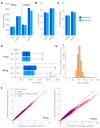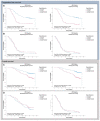Development of the NOGGO GIS v1 Assay, a Comprehensive Hybrid-Capture-Based NGS Assay for Therapeutic Stratification of Homologous Repair Deficiency Driven Tumors and Clinical Validation
- PMID: 37444554
- PMCID: PMC10341077
- DOI: 10.3390/cancers15133445
Development of the NOGGO GIS v1 Assay, a Comprehensive Hybrid-Capture-Based NGS Assay for Therapeutic Stratification of Homologous Repair Deficiency Driven Tumors and Clinical Validation
Abstract
The worldwide approval of the combination maintenance therapy of olaparib and bevacizumab in advanced high-grade serous ovarian cancer requires complex molecular diagnostic assays that are sufficiently robust for the routine detection of driver mutations in homologous recombination repair (HRR) genes and genomic instability (GI), employing formalin-fixed (FFPE) paraffin-embedded tumor samples without matched normal tissue. We therefore established a DNA-based hybrid capture NGS assay and an associated bioinformatic pipeline that fulfils our institution's specific needs. The assay´s target regions cover the full exonic territory of relevant cancer-related genes and HRR genes and more than 20,000 evenly distributed single nucleotide polymorphism (SNP) loci to allow for the detection of genome-wide allele specific copy number alterations (CNA). To determine GI status, we implemented an %CNA score that is robust across a broad range of tumor cell content (25-85%) often found in routine FFPE samples. The assay was established using high-grade serous ovarian cancer samples for which BRCA1 and BRCA2 mutation status as well as Myriad MyChoice homologous repair deficiency (HRD) status was known. The NOGGO (Northeastern German Society for Gynecologic Oncology) GIS (GI-Score) v1 assay was clinically validated on more than 400 samples of the ENGOT PAOLA-1 clinical trial as part of the European Network for Gynaecological Oncological Trial groups (ENGOT) HRD European Initiative. The "NOGGO GIS v1 assay" performed using highly robust hazard ratios for progression-free survival (PFS) and overall survival (OS), as well a significantly lower dropout rate than the Myriad MyChoice clinical trial assay supporting the clinical utility of the assay. We also provide proof of a modular and scalable routine diagnostic method, that can be flexibly adapted and adjusted to meet future clinical needs, emerging biomarkers, and further tumor entities.
Keywords: BRCA1; BRCA2; DNA repair; HRD; HRR; LOH; OS; PAOLA-1; PARP inhibition; PARPi; PFS; breast cancer; diagnostics; genomic instability; homologous repair deficiency; molecular pathology; ovarian cancer; somatic mutation.
Conflict of interest statement
Elena Ioana Braicu MD, PhD receives research funding from: Bayer, Roche Diagnostics, Tesaro, GSK, AstraZeneca and personal fees from: AstraZeneca, Clovis, GSK, Tesaro, EISAI, RochePharma, Roche Diagnostics; Michael Hummel Honorarium: Amgen, AstraZeneca, BMS, Lilly, Novartis, Pfizer, Pierre Fabre, ThermoFisher; Regina Berger receipt of grants/research supports to Institution: Merck, Pharma Mar, AstraZeneca, Kartos Therapeutics, Mersana Therapeutics, Novocure, Clovis Oncology, Seagen Inc.; Vanda Salutari Honorarium: AstraZeneca, MSD Oncology, GSK, PharmaMar and Novocure. Advisory role for Astra Zeneca and Novocure; Markus Tiemann Honorarium/Advisory role for: Astra Zeneca, Boehringer Ingelheim, BMS, MSD, Novartis, Lilly, Roche, Takeda; Lukas C. Heukamp Advisory role for Agilent, Astra Zeneca, Pfizer, BMS, Lilly, Roche.
Figures





Similar articles
-
Homologous Recombination Repair Gene Mutations to Predict Olaparib Plus Bevacizumab Efficacy in the First-Line Ovarian Cancer PAOLA-1/ENGOT-ov25 Trial.JCO Precis Oncol. 2023 Jan;7:e2200258. doi: 10.1200/PO.22.00258. JCO Precis Oncol. 2023. PMID: 36716415 Free PMC article. Clinical Trial.
-
In-house testing for homologous recombination repair deficiency (HRD) testing in ovarian carcinoma: a feasibility study comparing AmoyDx HRD Focus panel with Myriad myChoiceCDx assay.Pathologica. 2022 Aug;114(4):288-294. doi: 10.32074/1591-951X-791. Pathologica. 2022. PMID: 36136896 Free PMC article.
-
RediScore: Prospective validation of a pipeline for homologous recombination deficiency analysis.Oncol Lett. 2023 Sep 22;26(5):480. doi: 10.3892/ol.2023.14060. eCollection 2023 Nov. Oncol Lett. 2023. PMID: 37809048 Free PMC article.
-
Comparison of PARPi efficacy according to homologous recombination deficiency biomarkers in patients with ovarian cancer: a systematic review and meta-analysis.Chin Clin Oncol. 2023 Jun;12(3):21. doi: 10.21037/cco-22-114. Epub 2023 May 15. Chin Clin Oncol. 2023. PMID: 37211773
-
Homologous recombination deficiency real-time clinical assays, ready or not?Gynecol Oncol. 2020 Dec;159(3):877-886. doi: 10.1016/j.ygyno.2020.08.035. Epub 2020 Sep 20. Gynecol Oncol. 2020. PMID: 32967790 Review.
Cited by
-
AHRR and SFRP2 in primary versus recurrent high-grade serous ovarian carcinoma and their prognostic implication.Br J Cancer. 2024 May;130(8):1249-1260. doi: 10.1038/s41416-023-02550-1. Epub 2024 Feb 9. Br J Cancer. 2024. PMID: 38361045 Free PMC article.
-
Intergroup-statement: statement of the german ovarian cancer commission, the North-Eastern German Society of gynecological Oncology (NOGGO), AGO Austria and AGO Swiss regarding the use of homologous repair deficiency (HRD) assays in advanced ovarian cancer.Arch Gynecol Obstet. 2025 May;311(5):1445-1450. doi: 10.1007/s00404-025-07991-y. Epub 2025 Mar 12. Arch Gynecol Obstet. 2025. PMID: 40069521 Free PMC article. Review.
-
Unraveling Homologous Recombination Deficiency in Ovarian Cancer: A Review of Currently Available Testing Platforms.Cancers (Basel). 2025 May 25;17(11):1771. doi: 10.3390/cancers17111771. Cancers (Basel). 2025. PMID: 40507252 Free PMC article. Review.
-
Assessing the Phenotype of a Homologous Recombination Deficiency Using High Resolution Array-Based Comparative Genome Hybridization in Ovarian Cancer.Int J Mol Sci. 2023 Dec 14;24(24):17467. doi: 10.3390/ijms242417467. Int J Mol Sci. 2023. PMID: 38139296 Free PMC article.
-
Current HRD assays in ovarian cancer: differences, pitfalls, limitations, and novel approaches.Front Oncol. 2024 Aug 16;14:1405361. doi: 10.3389/fonc.2024.1405361. eCollection 2024. Front Oncol. 2024. PMID: 39220639 Free PMC article. Review.
References
LinkOut - more resources
Full Text Sources
Miscellaneous

